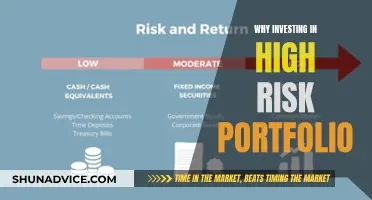
Investing in the Nasdaq 100 from India is possible and offers Indian investors the opportunity to diversify their portfolios by gaining access to some of the world's most dynamic and innovative companies. The Nasdaq 100 index comprises the top 100 non-financial corporations listed on the exchange, and accounts for more than 90% of the weighting of the Nasdaq Composite Index. There are two main ways to invest in the Nasdaq 100 from India: direct investment in stocks and indirect investment via mutual funds or ETFs.
Direct investment involves opening an overseas trading account with a domestic or foreign broker. This allows investors to buy stocks listed on the Nasdaq 100 indices directly. It is important to consider the associated costs, such as brokerage fees, currency exchange rates, and conversion charges.
Indirect investment can be done through mutual funds or Exchange-Traded Funds (ETFs). Mutual funds, particularly international or global funds, provide a way to invest in a diversified portfolio of stocks, including those listed on the Nasdaq 100. ETFs offer similar benefits and can be traded like stocks.
Regardless of the method chosen, it is essential for Indian investors to understand the tax implications, such as dividend tax and capital gains tax, as well as the Liberalized Remittance Scheme (LRS) set by the Reserve Bank of India, which allows individuals to remit funds for investments abroad.
| Characteristics | Values |
|---|---|
| Can Indians invest in the Nasdaq 100? | Yes |
| How to invest | Direct or indirect investment |
| Direct investment | Open an overseas trading account with a domestic or foreign broker |
| Indirect investment | Mutual funds or ETFs |
| Popular direct investment brokers | Interactive Brokers, Charles Schwab, Ameritrade |
| Popular ETFs | Invesco QQQ ETF, Motilal Oswal Nasdaq 100 ETF, ICICI Prudential Nasdaq 100 index fund |
| Popular mutual funds | ICICI Prudential NASDAQ 100 Index Fund, Motilal Oswal Nasdaq 100 FOF, Franklin India Feeder Franklin US Opportunities Fund |
| Investment amount | Up to $250,000 per year under the RBI's Liberalized Remittance Scheme |
| Taxation | Dividend Tax: 25% in the US, remaining amount taxable in India; Capital Gains Tax: 20% for long-term gains, short-term gains added to taxable income |
What You'll Learn
- Direct investment: Open an overseas trading account with a domestic or foreign broker
- Indirect investment: Invest in mutual funds or ETFs
- Liberalised Remittance Scheme: Allows Indian investors to remit up to $250,000 per year
- Geographical diversification: Access to global companies and ETFs with worldwide reach
- Taxation: Understand double taxation agreements and tax implications in India and the US

Direct investment: Open an overseas trading account with a domestic or foreign broker
To invest in the Nasdaq 100 from India, one method is to open an overseas trading account with a domestic or foreign broker. This allows you to invest directly in stocks listed on the Nasdaq exchange. Here's a detailed guide on how to do this:
Opening an Overseas Trading Account with a Domestic Broker
Many Indian domestic brokers have tie-ups with stockbrokers in the US, acting as intermediaries to execute trades on US stock exchanges. To open an account with a domestic broker, follow these steps:
- Choose a Broker: Select a domestic broker with ties to US stockbrokers, such as ICICI Direct, HDFC Securities, Kotak Securities, or Axis Securities.
- Submit Required Documents: You will likely need to submit a set of documents to open the account, including identity proof, address proof, tax ID proof, and bank statements.
- Be Aware of Restrictions: Keep in mind that there might be restrictions based on the brokerage firm. For example, there could be limitations on certain investment vehicles or the number of trades you can make.
- Understand the Costs: The cost of investing through a domestic broker can be high due to brokerage and currency conversion charges. Ensure you understand all the associated costs before opening the account.
Opening an Overseas Trading Account with a Foreign Broker
Alternatively, you can open an overseas trading account directly with a foreign broker that has a presence in India. Some popular options include Charles Schwab, Ameritrade, and Interactive Brokers. Here's what you need to do:
- Choose a Broker: Select a foreign broker that operates in India and offers access to the Nasdaq exchange.
- Understand the Fees: Foreign brokers may have different fee structures than domestic brokers, so be sure to review and understand their fees and charges before opening an account.
- Conduct Research: Properly research the available brokers to make an informed decision. Compare their fees, services, research capabilities, and customer support to find the best fit for your investment needs.
By opening an overseas trading account, either with a domestic or foreign broker, you can gain direct access to investing in the Nasdaq 100 from India. Remember to consider the costs, restrictions, and your investment goals before proceeding.
AI in 2030: Transforming Investment Management
You may want to see also

Indirect investment: Invest in mutual funds or ETFs
Indirect Investment: Mutual Funds or ETFs
If you're an Indian investor looking for indirect exposure to the Nasdaq-100 index, you can consider investing in mutual funds or exchange-traded funds (ETFs). Here's what you need to know:
Mutual Funds
Mutual funds are investment schemes that pool money from multiple investors to purchase stocks, bonds, or other assets. In the context of Nasdaq-100, you can invest in mutual funds that are classified as Funds of Funds (FOFs). These FOFs, in turn, invest in Nasdaq-100 ETFs, providing you with exposure to the index. Here are some key points to consider:
- Diversification: Nasdaq-100 FOFs offer diversification by giving you access to the US stock market, especially the technology sector, which may be underrepresented in the Indian stock market.
- Growth Potential: Nasdaq-100 FOFs invest in high-growth companies, including tech giants like Microsoft, Nvidia, and Google. This provides an opportunity to participate in the growth of these global leaders.
- Convenience: For Indian investors, Nasdaq-100 FOFs offer a convenient way to invest in US stocks without the need for a US bank account or stockbroking account.
- Professional Management: FOFs are managed by professional fund managers who have the expertise to navigate investments and aim to generate good returns.
- Currency Risk: Since investments are made in US dollars, fluctuations in the INR-USD exchange rate can significantly impact returns.
- Geopolitical Risks: Investing in FOFs tied to the US stock market exposes you to geopolitical risks, which can be unpredictable and negatively affect your returns.
- Tax Considerations: Under the Indian taxation regime, Nasdaq-100 FOFs are classified as debt mutual funds for tax purposes, so be sure to understand the tax implications before investing.
- Market Risk: The Nasdaq-100 is known for its high-growth companies, but it also comes with high volatility, leading to potential fluctuations in the value of your investments, especially in the short term.
ETFs
ETFs are baskets of securities that trade on an exchange like a stock. They offer several benefits, such as diversification, liquidity, and lower costs compared to mutual funds. When investing in Nasdaq-100 through ETFs, here are some key points to consider:
- Diversification: ETFs provide exposure to a basket of stocks within the Nasdaq-100 index, reducing the risk associated with investing in individual stocks.
- Liquidity: ETFs can be easily traded on an exchange, providing you with more flexibility and the ability to enter or exit your investment quickly.
- Lower Costs: ETFs generally have lower expense ratios compared to mutual funds, making them a more cost-effective option for long-term investors.
- Simplicity: ETFs are straightforward investment vehicles that mirror the performance of the underlying index, making them easier to understand and track.
- Tax Efficiency: In some cases, ETFs may offer more tax efficiency compared to mutual funds, but it's important to consult with a tax professional for specific guidance.
- Trading Flexibility: ETFs allow you to employ various trading strategies, such as buying on margin, short-selling, and using stop-loss orders, providing more flexibility in managing your investment.
When considering indirect investment options for the Nasdaq-100, mutual funds and ETFs each have their advantages and disadvantages. Be sure to carefully evaluate your investment goals, risk tolerance, and familiarity with these investment vehicles before making a decision.
A Guide to Investing in G-Secs in India
You may want to see also

Liberalised Remittance Scheme: Allows Indian investors to remit up to $250,000 per year
The Liberalised Remittance Scheme (LRS) is a foreign exchange policy initiative introduced by the Reserve Bank of India in 2004. It was designed to simplify and streamline the process of remitting funds outside of India, easing the restrictions set by the Foreign Exchange Management Act (FEMA) of 1999. The LRS allows Indian residents to freely remit funds for various permissible transactions, including investing in foreign markets such as the Nasdaq.
Initially, the LRS had an annual limit of USD 25,000, but this has since increased significantly. Currently, under the scheme, a resident individual can remit up to USD 250,000 per financial year. This substantial increase has opened up more opportunities for Indian investors to diversify their portfolios internationally.
To be eligible for the LRS, individuals must be residents of India, including minors, and must have an active Indian bank account, a valid Permanent Account Number (PAN), and a passport. The remitted amount can be used for various purposes, including educational expenses, business ventures, and personal investments.
It's important to note that the LRS has specific restrictions on certain types of transactions. For example, remittances for margin trading, purchasing real estate, or buying lottery tickets are not permitted. The scheme also has tax implications, with profits from overseas investments being taxable in India depending on the investment's holding period.
Overall, the Liberalised Remittance Scheme has made it simpler for Indian citizens to manage financial transactions and investments abroad, providing a great opportunity for those looking to diversify their portfolios internationally.
Investment Portfolio: Where to Find and How to Start
You may want to see also

Geographical diversification: Access to global companies and ETFs with worldwide reach
Investing in the Nasdaq 100 from India offers a great opportunity for geographical diversification, giving investors access to global companies and Exchange-Traded Funds (ETFs) with worldwide reach.
Nasdaq is home to some of the world's most dynamic and innovative companies, particularly in the technology sector. By investing in the Nasdaq 100, Indian investors can gain exposure to these companies and participate in their growth.
One way to achieve geographical diversification is through direct investment in stocks listed on the Nasdaq 100. This can be done by opening an overseas trading account with either a domestic or foreign broker. A foreign broker with a presence in India, such as Charles Schwab, Ameritrade, or Interactive Brokers, can be a good option. These brokers provide access to US stocks without restrictions on the number of trades or the type of investment.
Another way to diversify geographically is by investing in ETFs. ETFs offer a diversified portfolio of assets, often tracking a specific index, sector, or commodity. They can be easily traded on brokerage platforms, similar to stocks. One example of an ETF that tracks the Nasdaq 100 index is the Invesco QQQ Trust, which includes companies like Amazon, Apple, and Meta (Facebook) among its top holdings.
Indian investors can also gain exposure to global companies by investing in mutual funds, particularly international funds or funds of funds. These funds invest in stocks and securities of companies listed on the Nasdaq 100, providing indirect access to the US market. This option may be more expensive due to higher expense ratios, but it eliminates the need for an overseas trading account and associated charges.
Additionally, investors can consider purchasing Indian ETFs that invest in Nasdaq indices. These ETFs provide access to international markets without the need to open a new brokerage account in the US. However, it's important to be mindful of tracking errors that may impact your gains.
Geographical diversification through investing in the Nasdaq 100 from India offers Indian investors a chance to access a wide range of global companies and ETFs, helping them to diversify their portfolios and potentially mitigate risks associated with a single market.
Investment Managers: Guidelines for Success
You may want to see also

Taxation: Understand double taxation agreements and tax implications in India and the US
Taxation is a crucial aspect to consider when investing in the Nasdaq 100 from India. Understanding the tax implications and double taxation agreements between India and the US can help Indian investors make informed decisions.
Double Taxation Agreements:
The Indian government has signed a Double Taxation Avoidance Agreement (DTAA) with the United States to prevent double taxation of income earned in both countries. This agreement ensures that taxpayers do not bear the burden of paying taxes on the same income in both countries. The DTAA provides two main reliefs:
- Exemption Method: Income earned in one country may be entirely exempt from tax in the other country. For example, if an Indian resident earns income in the US, that income may be exempt from Indian taxes.
- Tax Credit Method: The taxpayer can claim a credit for the amount of tax already paid in one country against the tax liability in the other country. This ensures that the total tax paid is not more than the higher of the two countries' tax rates.
Tax Implications for Indian Investors in Nasdaq:
When investing in Nasdaq stocks, Indian residents must consider the following tax implications:
- Dividend Tax: Dividends from US stocks are subject to a flat 25% tax in the US. The remaining amount is then taxable in India according to the individual's income tax slab.
- Capital Gains Tax: While there is no capital gains tax in the US for foreign investors, any capital gains are taxable in India. Long-term capital gains (investments held for over 24 months) are taxed at 20%, while short-term gains are added to the investor's taxable income.
- Tax Collected at Source (TCS): As of July 1, 2023, all remittances under the Reserve Bank of India's Liberalized Remittance Scheme (LRS) are subject to TCS, regardless of whether they are incurred within India or abroad.
Key Considerations:
It is important to note that the DTAA between India and the US applies to residents of both countries who earn income in one or both nations. Additionally, the agreement covers specific types of taxes, including federal income tax in the US and Indian income tax. Understanding the eligibility criteria and conditions for claiming DTAA benefits is essential.
In summary, Indian investors in Nasdaq should be mindful of the tax implications in both the US and India. The DTAA between the two countries provides relief from double taxation, ensuring that investors do not pay taxes on the same income twice. By understanding and adhering to the tax regulations in both countries, Indian investors can make informed decisions and comply with their tax obligations.
Fidelity's Investment Management: Is It Right for You?
You may want to see also
Frequently asked questions
There are two main ways to invest in the Nasdaq 100 from India: direct and indirect investment. Direct investment involves opening an overseas trading account with a domestic or foreign broker and buying stocks listed on the Nasdaq 100. Indirect investment involves investing in mutual funds or ETFs that provide exposure to the Nasdaq 100.
Indian residents investing in the Nasdaq 100 are subject to dividend tax and capital gains tax. Dividends from US stocks are taxed at a flat rate of 25% in the US, and the remaining amount is taxable in India according to the individual's income tax slab. Capital gains made from investments held for more than 24 months are taxed at 20% in India, while short-term gains are taxed at the individual's income tax slab rate.
Investing in the Nasdaq 100 provides access to some of the most dynamic and innovative companies in the world, particularly in the technology sector. It allows Indian investors to diversify their portfolios beyond the Indian stock market and participate in the growth of global companies. The Nasdaq 100 has also historically outperformed other stock markets, providing attractive returns.







